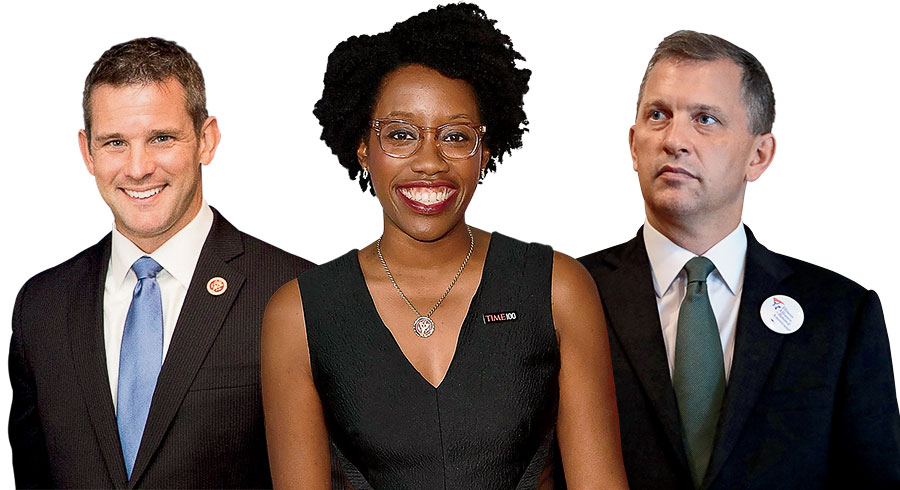
At each of the four holiday parties that Illinois Action for Children threw in December, the festive theme was the 2020 census. Partygoers played Census Klaus Bingo, in which the caller read out fun census facts. And throughout the winter, whenever parents have called in to check on the status of a childcare assistance application, they’ve heard a spiel about filling out the form.
“We’re going full bore on this,” says CEO Maria Whelan, whose nonprofit connects families with childcare and preschools. “Every employee is going to be a babbling idiot about the census.” The state can’t afford a repeat of what happened 10 years ago: Kids younger than 5 were undercounted by 36,000, costing Illinois $2,700 per child each year in federal assistance.
In all, the United States Census Bureau estimates it missed 59,800 Illinoisans the last time around. As a result, the state lost $122 million in federal health funding, according to the George Washington Institute of Public Policy. So it’s no surprise that Illinois is spending more than it ever has on the census, including $29 million from Springfield, $4 million from Cook County, and $2.7 million from Chicago. Illinois’s investment is the third highest per capita, after California and New York.
It’s not just federal funding at stake. Because its population dropped in the 2010s, Illinois is all but guaranteed to lose one U.S. House seat. (Connecticut, Vermont, and West Virginia are the other states that had declines, but Illinois’s was steepest, with six consecutive years of losses.) But if the undercount is large enough, the state could lose two seats. According to the latest projections from the political consulting firm Election Data Services, that would only happen if residents were undercounted by more than 126,000. Should that be the case, the state’s House delegation would get reduced to 16 seats, its fewest since Abraham Lincoln was president.
A particular challenge for Illinois: its high percentage of hard-to-count residents, especially immigrants. The state has 1.8 million foreign-born inhabitants, the nation’s sixth-highest total. And immigrants account for the population increase in the few parts of Illinois that are growing, especially the Fox River Valley. (Latinos are now the largest ethnic group in Aurora and Elgin.) It’s not news that immigrants — even legal ones — participate in the census at a lower rate than native-born Americans. This year, though, getting them to fill out a form will be even tougher, thanks to fears stoked by the Trump administration’s efforts to add a citizenship question to census forms. While the Supreme Court rejected the question, just the fact that it was proposed has left many immigrants wary. Organizations that sued to keep the question off the census claimed it was intended to reduce the participation, and thus the political representation, of Latinos, who make up about 17 percent of Illinois’s population.
“We’ve got a lot to fight in terms of government mistrust,” says Jeanine Stroger, who is coordinating the Illinois Complete Count Committee for the Illinois secretary of state’s office. “That whole discussion left a chilling effect in the community.” Her office is distributing literature in five languages to municipal libraries, assuring residents that their individual census information will not be made public for 72 years.
Griselda Vega Samuel, Midwest regional counsel of the Mexican American Legal Defense and Educational Fund, sits on the Complete Count Committee and has been making census presentations at Chicago-area legislators’ town halls. When Samuel appeared with state representative Chris Welch in Maywood, she had to reassure nervous attendees that their census forms would not be shared with Immigration and Customs Enforcement. It was important for Latino immigrants to hear that from a fellow Latino, believes Samuel, whose parents came to Chicago from Mexico: “When it comes to reaching certain communities, you need people who speak the language.”
That’s why most of the $29 million the state appropriated for the census will be distributed as grants to community organizations, say statewide census directors Marishonta Wilkerson and Oswaldo Alvarez. (Illinois Action for Children is getting $1.75 million, some of which it will pass on to neighborhood institutions, such as a learning center in Lawndale.) In Uptown, 13 groups are involved “just because of the demand of different languages there,” says Wilkerson. Besides engaging in door-to-door information campaigns, the state is encouraging grantees to hold “census parties,” where people can answer the census’s nine questions on computers or tablets.
Never before has Illinois worked so hard to count every resident, but it’s also never had to contend with the suspicion that the federal government doesn’t want everyone counted. “The census has been politicized,” says Vega. An accurate count may be a federal responsibility, but the burden of failure falls on states.
Where Would Illinois Lose Its Congressional Seats?

After peaking at 27 U.S. House representatives in Congress during the 1930s, Illinois has lost at least one seat in every census since 1940. In 1980 and 1990, it lost two each. Now the state is down to 18 representatives — and conceivably could drop to 16 after the 2020 census. The seat it is almost sure to lose will come out of southern Illinois, says Kent Redfield, professor emeritus of political science at the University of Illinois Springfield. The Democrats will control redistricting and “are not looking to do the Republicans any favors.”
In the unlikely case of a second lost seat, that one would probably be eliminated in the northern part of the state. The Democrats could draw a map that cuts out the seat of Adam Kinzinger, a Republican congressman whose 16th District stretches like a collar outside the metro area, from Rockford to Watseka. That would require adding more GOP voters to the traditionally conservative suburban districts of Democratic freshmen Sean Casten in the 6th and Lauren Underwood in the 14th. Another tricky decision: whether to maintain three African American districts (1st, 2nd, and 7th) and one Latino district (4th) or to draw two of each, since Latinos will outnumber blacks in Illinois.


